|
| |
| Vincent Engineers (Stevenage) Ltd. | |
| Formerly | Vincent H·R·D Company Ltd. |
| Industry | Manufacturing and engineering |
| Founded | 1928 |
| Founder | Philip Conrad Vincent |
| Defunct | 1959 |
| Fate | Bankrupt |
| Successor | Harper Engineering (Stevenage) [1] [2] [3]: 31 |
| Headquarters | Stevenage, Hertfordshire, England |
Key people |
|
| Products | Motorcycles, three-wheelers, personal watercraft, aircraft engines, stationary and industrial engines. |
Vincent Engineers (Stevenage) Ltd. is a British engineering firm best known as a manufacturer of high-performance motorcycles. The business was established by Philip Conrad Vincent (PCV) who bought an existing manufacturing name HRD, renaming it the Vincent H·R·D Company Ltd., under which name it operated for most of the company's life. As Vincent H·R·D the company began producing motorcycles using bought-in engines. In 1934 an in-house 499 cc (30.5 cu in) single-cylinder engine was developed, followed by a 998 cc (60.9 cu in) V-twin in 1936. Production grew from 1936, with the most-famous models being developed from the original designs after the War period in the late 1940s. [3]: 27–31
The 1948 Vincent Black Shadow was at the time the world's fastest production motorcycle. [5] The name was changed to Vincent Engineers (Stevenage) Ltd. in 1952 after financial losses were experienced when releasing capital to produce a Vincent-engined prototype Indian (Vindian) for the US market during 1949. [3] In 1955 the company discontinued motorcycle production after experiencing further heavy financial losses.
Key People
Howard Raymond Davies
Howard Raymond Davies was a British Royal Flying Corps (RFC) pilot who was shot down and captured by the Germans in 1917. Legend has it that it was while a prisoner of war that he first conceived the idea of building his own motorcycle. In 1924 Davies entered into partnership with E. J. Massey and established HRD Motors. Various models were produced, generally powered by J.A.P. engines.
Unfortunately, although HRD motorcycles won races, the company ran at a loss. In January 1928 it went into voluntary liquidation. The company was initially bought by Ernest Humphries of OK-Supreme Motors for the factory space, and the HRD name, jigs, tools, patterns, and remaining components were subsequently offered for sale again.
Phiip Conrad Vincent
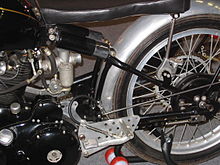
Advised to buy existing company. [6]
Book above is quoted in MPH. [7]
Philip Vincent went to inquire of Arthur Bourne (aka "Torrens") whether to buy established name. Considering two, leaning towards H·R·D due to TT wins. He had built a motorcycle of his own in 1927 and in 1928 had registered a patent for a cantilever rear suspension of his own design. With the backing of his family wealth from cattle ranching in Argentina, Vincent acquired the trademark, goodwill and remaining components of H·R·D from Humphries for £450 in 1928.

The company was promptly renamed Vincent H·R·D Co., Ltd and production moved to Stevenage. The new trademark had The Vincent in very small letters above the large "H·R·D". After World War 2 Britain had an export drive to repay its war debts, and the USA was the largest market for motorcycles, so from 1950 the H·R·D was dropped from the name to avoid any confusion with the "HD" of Harley Davidson, and the motorcycle became The Vincent. [8]
In 1928 the first Vincent H·R·D motorcycle used a JAP single-cylinder engine in a Vincent-designed cantilever frame. The earliest known example extant exists in Canberra, Australia. Some early bikes used Rudge-Python engines. But after a disastrous 1934 Isle of Man TT, with engine problems and all three entries failing to finish, Phil Vincent and Phil Irving decided to build their own engines.
Phil Vincent also experimented with three-wheeled vehicles, amphibious vehicles, and automobiles.
Frank Walker
Managing director. With Vincent when company was founded.(Confirm this) Refused to approve development of Black Shadow.
Bill Clarke
Convinced father to invest, appointed to board. Racing exploits, died in WWII. [9]
Philip Edward Irving

In late 1931 Philip Edward Irving (PEI) first joined Vincent as an engineer alongside fellow-engineer E.J. Massey from the original HRD company after initially working on metallurgy for Velocette, leaving to return to his native Australia in 1949. [3] His first engine design was an OHV 500 cc single-cylinder engine in 1934 called the "Meteor". [4]: 350 [10]
Ted Davis
Not sure what his role was. Infobox says "Chief tester". Need more info.
George Brown
Company timeline
1920s
- 1927 - Phil Vincent builds a prototype motorcycle with a cantilever rear suspension and a triangulated frame.
- 1928 - Vincent buys the assets of HRD Motors Ltd, less the factory premises, and establishes Vincent H·R·D in May.
1930s
- 1932 - Vincent Bantam delivery van goes into production.
- 1936 - Series A Rapide is launched in October.
- 1937 - Phil Irving leaves Vincent H·R·D to work for Velocette.
- 1939 - Motorcycle production is stopped. The factory is repurposed to wartime production of such general parts as fuses, land-mine casings, and components for the aeroplane industry. [11]: 19, 20
Vincent primarily made munitions, but Vincent engines were trialled in boats and portable pumps during the war, and the end of hostilities saw Vincent ready to return to motorcycle production.
1940s
- 1943 - Irving returns to Vincent H·R·D.
- 1944 - Eugene Aucott opens the first USA dealership in the city of Philadelphia. Others would follow.
During the Korean War nickel chrome steel was officially regulated, meaning the correct materials for some components (e.g. gears) was not available. [12]: 65 Some motorcycles built during this period had black rims.
1950s
- 1950 - The company discontinues use of the H·R·D monogram. The logo now simply reads The Vincent and cast parts read Vincent. [3]: 29 Vincent is trying to enter the American market and does not want any confusion with the H D initials of the American Harley-Davidson. [13] [8] [3]: 29
- 1955 - At the annual dinner of the Vincent H.R.D. Owners Club in the summer of the year, Phil Vincent announces that the company can no longer continue in the face of heavy losses and that production of motorcycles would cease almost immediately. [14]
- 1955 - One week before Christmas, the last Vincent comes off the production line and is promptly labelled "The Last".
- 1959 - The company goes into receivership. The name and motorcycle component manufacturing rights, initially taken over by Harper Engines Ltd., of Stevenage, Herts., have since been bought and sold by other engineering firms. [1] [2]
1970s
In the early 1970s the Vincent Owners Club created via public subscription the VOC Spares Company Ltd to ensure continued availability of spares. The company is independent of the club who retain a majority share holding. [15] [16][ better source needed]
Product history
Vincent Bantam
In 1932 Vincent introduced the Bantam three-wheeled delivery van. This vehicle was powered by a 293 cc SV JAP or 250 cc Villiers engine, weighed 2.5 cwt and used a car seat and steering wheel rather than the standard motorcycle saddle and handlebars. The Bantam was priced at £57-10-0 with a windscreen and hood available for an additional £5-10-0. Production ended in 1936. [17]
Meteor and Comet
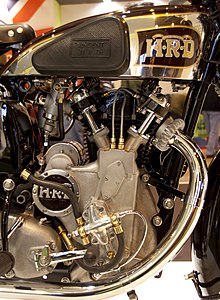
Following a disappointing outing with JAP-powered Vincents at the 1934 Isle of Man Tourist Trophy (TT), the two Phils became convinced that future success depended on the company developing its own engine.
The motorcycle that received the new motor in standard tune was called the Meteor, and the one with the sports motor was the Comet; it was distinguished from earlier Vincent models of that name by the "Series-A" prefix. There was a TT replica & the Comet Special (basically a TTR with lights, horn etc.), which used a bronze head. [18] The Meteor motor produced 26 bhp (19 kW) @ 5300 rpm,
An unusual feature of the valve design for these motors was the double valve guides, and the operation of the forked rocker arm on a shoulder between the guides, to eliminate side forces on the valve stem and ensure maximum valve life under racing conditions.
The Series-A Comet was capable of 90 mph (140 km/h).
Series A

The Series A line began with the release of the Vincent Rapide in October 1936. This bike was powered by a V-twin engine derived from the Vincent single and which used many common parts. Only a few weeks separated the conception of the engine from the first running prototype. [19]: 93, 94 The 998 cc engine produced 45 hp (34 kW). The gearbox was a Burman unit separate from the engine.
The frame was a stretched version of the diamond frame used by the Meteor and Comet. Front and rear suspension were also shared with the single-cylinder bikes, being a version of the Vincent cantilever system in back and a Brampton girder fork in front.
Following the introduction of the Series A Rapide, subsequent Meteor and Comet bikes were also classified as Series A Vincents.
Vincent lifeboat engine
Vincent developed a highly efficient opposed-piston two-stroke engine for use in air-dropped lifeboats, although development outlasted the war and it never went into service.
Uniflo (Uniflow?) Air-sea rescue boat engine. [20]
Used in a prototype car with a plywood body made by De Havilland aircraft company. Never put into production, and the prototype was cut up for firewood by factory employee. [21]: 53
Vincent was contracted by the Signals Research and Development Establishment (SDRE) to develop a version of the Vincent marine engine with twice the number of cylinders as a portable generator unit. [22] This project also did not go into production.
Series B
The Series B Rapide designed during the war and released to the press before end of hostilities looked radically different from the A. The oil pipes were now internal. Unit construction allowed Vincent to combine the engine and gearbox into a single casing. Philip Vincent summarised his frame design philosophy in his memoirs, writing "What isn't present takes up no space, cannot bend, and weighs nothing — so eliminate the frame tubes!" [11]: 35 The angle between the cylinders was changed to 50° from the 47.5° of the Series A engine to allow the engine to be installed as a stressed member. This enabled Vincent to reduce the frame to an upper frame member (UFM) that was a steel box-section backbone that doubled as an oil tank, and to which the front headlug and rear suspension were attached. Brakes were dual single-leading shoe (SLS), front and rear. The 56.5-inch (1,440 mm) wheelbase was 1.5 in (38 mm) shorter than the Series A, and its dimensions were closer to contemporary 500 cc bikes. [11]: 124–127
A hydraulic shock absorber and spring assembly later replaced the original twin springboxes and friction damper. The rear seat was supported by a sub-frame down to the rear frame pivot point, providing a semi-sprung seat with 6 inches (150 mm) of suspension. (Yamaha would rediscover this suspension system nearly 40 years later.)
The Series B had a Feridax Dunlopillo Dualseat. [23] A tool tray was located under the front of the seat.
The Series "B" incorporated an inline felt oil filter instead of the metal gauze of the Series "A".
Vincent used quickly detachable wheels, making wheel and tyre changes easier. The rear wheel was reversible, and different size rear sprockets could be fitted for quick final-drive ratio changes. The brake & gear shift were adjustable for reach to suit individual feet. The rear mud guard was hinged to facilitate the removal of the rear wheel.
From today's perspective, it seems incongruous that Vincent could see the need for, and design, a cantilever rear suspension, as well as incorporate so many other new ideas, yet use Brampton girder forks with friction dampers up front. The two Phils felt that the telescopic forks of the time were prone to lateral flex, so they persisted with girder forks, and did use hydraulic damping in the Series C "Girdraulic" forks.
Starting in 1948, Indian Motorcycles distributed Vincents in the United States along with other British motorcycles including AJS, Royal Enfield, Matchless and Norton. [24] That same year an Indian Chief was sent to Stevenage to be fitted with a Vincent Rapide engine. The resulting hybrid Vindian did not go into production.
Speedway engine and Vincent Vampire
Single cylinder speedway engine/motorcycle. Hybrid engine (old/new, different number of cylinder head studs). Deal fell through when ??? Ham wanted exclusive worldwide distribution rights.
Series C
Black Shadow and Black Lightning

The 1948 Series C Rapide differed from the Series B in having "Girdraulic" front forks – which were girder forks with hydraulic damping. By 1950, the Series C featured a 998cc, 50-degree V-twin that put out between 45 and 55 horsepower, depending on the state of tune (Rapide or Black Shadow). [25]
The Black Shadow, capable of 125 mph (201 km/h), and easily recognised by the black coating on the engine and gearbox unit known as Pylumin, [3]: 73 [26] and large 150 mph (240 km/h) speedometer, was introduced. The engine produced 54 bhp (40 kW) @ 5700 rpm in Black Shadow trim.
The Black Lightning was a racing version of the Black Shadow; every necessary steel part on it that could be was remade in aluminium, and anything not essential was removed altogether. These changes helped reduce the weight from 458 lb (208 kg) to 380 lb (170 kg). Every bit the racer, it had a single racing seat and rear-set footrests.
American motorcycle racer Rolland "Rollie" Free set a new American motorcycle land speed record in 1948 on the Bonneville Salt Flats, Utah on a Vincent Black Lightning. [27]: 33–39 [28] The picture of Free, prone and wearing a bathing suit, has been described as the most famous picture in motorcycling. [29] Russell Wright won another World Land Speed Record at Swannanoa with a Vincent H·R·D motorcycle in 1955 at 184.83 mph (297.46 km/h).
The 500 cc Meteor and Comet singles were introduced, along with a 500 cc racer, the Vincent Grey Flash. The Grey Flash racer used Albion gears, for the greater choice of ratios available. [30] The 500 cc bikes used a wet multiplate clutch, while the 998 cc V-twins used a dry, drum-type servo clutch.
Most Vincents had black tanks and frames. In 1949 a White Shadow (a machine to Black Shadow mechanical specification, but with silver engine casings) was available, but only 15 were sold, and the option was dropped in 1952. In 1950 16 Red Comets were shipped to the United States. There were also 31 of the 1948 Grey Flash built. [31]
Series D
The term "Series D" was not used by the factory, but was taken as a natural progression by the motorcycling world, and indicates a change of the rear subframe with a new seat support, which freed the passenger footpegs from the swingarm-connected-seat struts of the Series B and C models. With sales falling, Vincent tried modernizing his existing line by enclosing the motorcycles in fiberglass bodywork; fairings, engine shrouds, and an enclosed tail section; these were named the Victor (based on the Comet), the Black Knight (based on the Rapide) and the Black Prince (based on the Shadow). They were poorly received by the public, and suffered delays in production, waiting for the new bodywork. A short-lived unfaired version of the Black Prince was then produced, and a Series D Comet.
Sales continued to decline after the post-war motorcycling boom owing to the availability of cheaper motor cars, so not many "Series D" models were made.
Firefly and Power Cycle
The Firefly was a 45 cc (2.7 cu in) "clip-on" engine for bicycles built from 1953 to 1955 under licence from Miller, who were suppliers of electrical components to Vincent. A complete motorised bicycle known as the Vincent Power Cycle was also available. [32] The Vincent Owners Club was predictably surprised by this new, cheap, entry-level Vincent. [33]
Vincent Three Wheeler
In 1954/1955, due to falling sales of motorcycles, a prototype 3-wheeler powered by a Vincent Rapide engine was produced. To keep development and production costs low, it used a parts-bin approach, including pieces from Vincent motorcycles, as well as wheels which came from a Morris Minor. The body was made from 16-gauge aluminium. With the standard Rapide engine, the unnamed three-wheeler could reach 90 mph (140 km/h). Before it was sold it achieved 117 mph (188 km/h) in the hands of Ted Davis with a Black Lightning engine. Some years later the vehicle was named "Polyphemus" by its then owner, Roy Harper. The "Vincent 3-wheeler" was eventually sold to a member of the public for £500 – a high price for any vehicle at the time, especially for a vehicle with no reverse gear, self-starter or hood. [17] The BMC Mini launched four years later at a price of £497. [34]
Ponton body.
NSU Fox and NSU Quickly
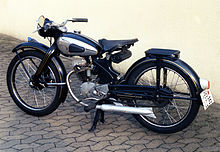
Vincent motorcycles were hand-built and expensive – a total of just 11,000 machines were sold post–World War Two. A sales slump in 1954 forced the company to import and sell NSU mopeds. One hundred sixty two-stroke Foxes NSU-Vincent 123 cc were built. There were also 40 98cc OHV four-stroke NSU-Vincents, and Vincent also sold the NSU Quickly moped; too well it appears (selling about 20,000 in one year – a footnote to how the market had changed again), as NSU took control of its own sales after a year.
Amanda water scooter

The factory then turned to general engineering, the manufacture of industrial engines, and there was the Amanda water scooter. [35] A Vincent engineer lost his life testing it, drowning at sea. [36]
Vincent Picador
In an attempt to diversify the company, Phil Vincent undertook development of a version of the motorcycle V-twin for aircraft applications. [12]: 65 Development of this engine, named Picador, began in 1951 and continued until 1954, diverting funds from the motorcycle product line.
The Picador was intended to power ultra-light aircraft. [37] In particular the engine was to be used in the ML Aviation U120D Queen Bee pilotless target drone. [38]: 254–256 To qualify for the government contract the motor had to be capable of passing prolonged full power operation tests.
Initially built to Black Lightning specifications, the engine followed typical Vincent practice, with two air-cooled cylinders in a 50° V-formation and with the cylinders offset to improve cooling of the rear cylinder's exhaust valve. Swept volume was 998 cc (60.9 cu in), weight was 200 lb (91 kg), and power output was 65 hp (48 kW) @ 5000 rpm. The valves were operated by rockers and short pushrods driven by two camshafts mounted high in the engine's timing case, an arrangement euphemistically called "semi-overhead camshafts". The Picador motor was upgraded with a larger mainshaft, different big-ends, Scintilla magneto, and a double speed oil pump. To prevent fuel starvation during the U120D's rocket-assisted launch when accelerations of 10Gs would be generated, mechanical fuel injection driven from the propeller shaft replaced the usual carburettors. Unusually for an aircraft engine, the engine was mounted with the crankshaft transverse, although in the Queen Bee drone the engine was rotated 180° from its motorcycle applications, with the exhaust ports at the rear. An oilbath chain primary drive and a bevel gear drove the propeller with a 2:1 reduction from the engine speed.
Due to ML Aviation's inability to deliver a working radio control system, Vincent did not win the contract.
Russel Wright's record breaking bike was fitted with a Picador crank and oil pump, by Vincent, while in England for Earls Court, shortly after the 1955 record attempt. [39]
Series E
Many references to Series E dreaming of successor to Series D. http://www.motohistory.net/featuredstory/vincent/vincent_feature1.html https://www.veloce.co.uk/shop/products/popup.php?prod_id=V4902&text=Chapter%20Titles http://www.voc.uk.com/net/docs/19.16/19-599-40.pdf
Stationary engine
Vincent lawn mower
Delta/opposed-piston engine
Late three-wheeler
Hybrids and attempted revivals
Norvin
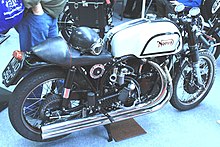
Vincent engines have been fitted to other frames. The most common was the Norvin, using a Norton Featherbed frame. Other names were used, including Vincent–Norton, Vinton and Vin–Nor. [40]: 34–35

Whereas most were one-off builds, an early attempt at production was announced by Staffordshire engineer Tom Somerton in late 1959, with an intended low-volume run from 1960. [41] It's not known how many were completed.
New Norvins were announced by Hailwood Motorcycle Restorations in 2008. [42] The brand was associated with David Hailwood ( Mike Hailwood's son) and bike restorer John Mossey. The business soon was dissolved. [43]
The Norvin is now available from John Mossey under a new brand, JMC Classics, together with the Egli-framed Vincent.
Egli Vincent
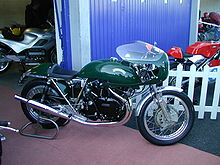
Fritz Egli, a specialist frame manufacturer based in Switzerland, produced an Egli-Vincent, and around 100[ citation needed] were produced between 1967 and 1972.[ clarification needed] Egli-Vincents were subsequently built under licence in France by Patrick Godet. [44] JMC Classics also produce new Egli framed Vincents in UK.
Vincent RTV Motorcycles

In 1996 a new motorcycle company was formed by Vincent enthusiast and specialist Terry Prince and Ron Slender, who were joined in 1998 by metallurgical engineer Rodney Brown. [12]: 291–294 Brown provided the financial start and along with Prince were the founding directors, with Slender specialising with business development post-production. The company was named RTV Motorcycles. Its aim was to produce a modern-day Vincent motorcycle that could be marketed in reasonable volumes worldwide. It used a redesigned and modernised version of the Vincent engine, engineered by Prince with increased capacity, in an Egli-style frame. The motorcycles were to be built individually by hand.
The range was to include both a touring and sports model in capacities of 1,000 cc (RTV1000) and 1,200 cc (RTV1200). Complete new engines would also be made available for separate purchase. Production was initially to begin for the larger capacity machine designated the RTV1200. These were to be fitted, as standard, with state of the art; Bosch electric start, Brembo brakes, adjustable Paioli upside down forks, Ohlins rear monoshock and V-2 multiplate clutch. The first factory prototype RTV was built in 1998; other RTV prototypes were in various stages of completion before the company went into voluntary liquidation towards the end of that year. [45]
Vincent Motors
Vincent Motors USA founder and president, Bernard Li, acquired the Vincent trademark in 1994 and formally launched Vincent Motors USA in 1998, spending about $2 million building prototypes that resemble the original Vincent but utilised modern components like the Honda RC51 V-twin engine. Vincent Motors was based in San Diego. [46]
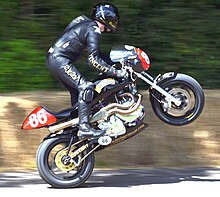
A resurrection of the Vincent name is now unlikely as the RC51 engine is out of production, and Li was killed in a single-bike crash in Arizona in 2008. [47]
Irving Vincent
The Irving Vincent is produced in small numbers by HRD Engineering (Horner Race Development - Ken and Barry Horner) in Hallam, Victoria, Australia. It is a re-engineered version based on the original drawings by Irving, with engine capacities of 1000 cc, 1300 cc or 1600 cc. [48] [49]
The marque gained worldwide recognition by winning the Daytona ( Florida, US) ‘Battle of the Twins’ in its first attempt in 2008, ridden by Craig McMartin. [50]: 21 [51]
See also
References
- ^
a
b "Vincent Harper Engines Ltd. (ad)". Motorcycle Mechanics. August 1961. p. 69.
{{ cite magazine}}: Cite has empty unknown parameter:|1=( help) - ^ a b Lawless, Bill (September 1964). "'Black Shadow - Harper Engineering rebuild, road test". Motorcycle Mechanics. p. 34-35, 56.
- ^ a b c d e f g h Minton, Dave (September 2002). "The Vincent Story". Classic Bike.
- ^ a b c Holliday, Robert 'Bob' (July 1979). "P.C. Vincent - A tribute". Motorcycle Sport.
- ^ Ward, Ian (1987). Great British Bikes. Macdonald & Co. ISBN 0-7481-0020-2.
- ^ Bourne, Richard, ed. (28 November 2016). Behind the Scenes in the Vintage Years. Troubador Publishing. ISBN 978-1785898525.
- ^ Webber, John. "From Undergraduate to Manufacturer" (PDF). MPH. Vol. 385. Retrieved 1 February 2018.
- ^ a b "The Club — The Marque's History". www.voc.uk.com. Retrieved 11 January 2018.
- ^ Bickerstaff, Jacqueline. "Riders Roll of Honour" (PDF). MPH. Retrieved 1 February 2018.
- ^ "Vincent Motors History". Vincent Motors. Vincent Motors, USA. 2004. Archived from the original on 2 July 2010. Retrieved 22 October 2006.
- ^ a b c Bickerstaff, J P (1997). Original Vincent Motorcycle. Bideford, Devin UK: Bay View Books Ltd. ISBN 1-870979-83-4.
- ^ a b c Guyony, Phillippe (1 December 2016). Vincent Motorcycles: The Untold Story since 1946. Veloce Publishing. ISBN 978-1845849023.
- ^ Irving, Phil (June–July 1973). "The Black Shadow Story". Two Wheels. Retrieved 2 January 2018.
- ^ "Vincent Motors History Page3". Archived from the original on 17 October 2006. Retrieved 11 January 2018.
- ^ "Vincent Spares". www.cinventspares.co.uk.
- ^ "Information on the Spares Company". Archived from the original on 19 August 2016. Retrieved 1 February 2018.
- ^ a b "Vincent". www.3wheelers.com. Retrieved 11 January 2018.
- ^ "NTNOA Histories − The Vincent". www.ntnoa.org. Retrieved 31 January 2018.
- ^ Harper, Roy (1975). The Vincent H.R.D. Story. Vincent Publishing Company. ISBN 978-0950418650.
- ^ Biberman, Matthew (30 April 2009). Big Sid's Vincati: The Story of a Father, a Son, and the Motorcycle of a Lifetime. Hudson Street Press. ISBN 978-1594630538.
-
^ Harper, Roy (1985). Vincent Vee Twins – The famous 1000 series, plus 500 singles. 12-14 Long Acre, London: Osprey Publishing Limited.
ISBN
0-85045-435-2.
{{ cite book}}: CS1 maint: location ( link) - ^ "Proposed Range of Gasoline Engine-Electric Power Units for Post-War Development" (PDF). www.nsa.gov.
- ^ "Vincent Motorcycle Models". www.thevincent.com. Retrieved 1 February 2018.
- ^ Greg Williams (September–October 2009). "The Last Vincent Black Lightning?". Motorcycle Classics. Retrieved 27 October 2010.
- ^ Clement Salvadori (March–April 2007). "Riding the Big Sur on a 1950 Vincent Series C Rapide". Motorcycle Classics. Retrieved 27 October 2010.
- ^ Brumwell, R. "The Painting of the Vincent" (PDF). MPH. Vol. 231. Retrieved 1 February 2018.
- ^ Wasif, Basem (15 October 2007). Legendary Motorcycles. Motorbooks. ISBN 978-0760330708.
- ^ Ensanian, Greg (22 November 2016). Discovering the Motorcycle: The History. The Culture. The Machines. Equus Potentia Publishing. p. 414. ISBN 978-0996391900. Retrieved 31 December 2017.
- ^ "Rollie Free". www.motorcyclemuseum.org. AMA Motorcycle Hall of Fame Museum. Retrieved 10 July 2009.
- ^ "Grey Flash Motorcycles". www.thevincent.com. Retrieved 12 January 2018.
- ^ "Vincent Motorcycle Serial Numbers and Post-War Production Records". www.thevincent.com.
- ^ "The Vincent Firefly 1953-1956". cyclemaster.wordpress.com.
- ^ Green, Peter (February 1996). "Vincent Firefly". Retrieved 31 January 2018.
- ^ "A glance at the history of this legendary car". Archived from the original on 21 July 2010. Retrieved 11 January 2018.
- ^ "British motorcycle manufacturers - V". www.ianchadwick.com. Retrieved 12 January 2018.
-
^
"Archived copy". Archived from
the original on 2 September 2006. Retrieved 1 February 2018.
{{ cite web}}: CS1 maint: archived copy as title ( link) - ^ Baker, Alan (5 June 1953). "POWER for ULTRA-LIGHT AIRCRAFT". Flight: 721–724. Retrieved 26 December 2017.
- ^ "Guided Midget". Flight. 28 August 1953.
- ^ "The Vincent Picador Drone". www.thevincent.com. Retrieved 1 February 2018.
- ^ "Vin–Nor sprinter". Motorcycle Mechanics. December 1964.
- ^ "British big twin comeback". Motor Cycle News. 30 December 1959.
- ^ Ash, Kevin (14 November 2008). "Vincent replicas: quality and nostalgia". www.telegraph.co.uk. Retrieved 1 February 2018.
- ^ "Hailwood Motorcycle Restorations Limited". www.companiesintheuk.co.uk. Retrieved 1 February 2018.
- ^ "Egli-Vincent". www.godet-motorcycles.com. Retrieved 1 February 2018.
- ^ Brown, Rodney. "History of RTV Motorcycles". The A - Z of motorcycles. Retrieved 1 February 2018.
- ^ "Vincent Motors". 2004. Archived from the original on 10 July 2010. Retrieved 31 January 2018.
- ^ Edwards, David (5 May 2008). "Bernard Li, 1946-2008 - First Look". Cycle World. Retrieved 1 February 2018.
- ^ Cameron, Kevin (28 September 2008). "The Irving Vincent: A Modern, High-Performance Black Lightning - First Look". Cycle World. Retrieved 1 February 2018.
- ^ Cathcart, Alan (1 July 2011). "Irving Vincent 1600 Daytona: Simple is best". Archived from the original on 24 March 2016. Retrieved 31 January 2018.
- ^ Hooker, Somer (June 2008). "Vintage Daytona 2008". Walneck's Classic Cycle Trader. Dominion Enterprises.
- ^ Cathcart, Alan (9 March 2012). "AMCN: Simple Is Best". Archived from the original on 1 June 2014. Retrieved 4 January 2018.
Cite error: A
list-defined reference named "Holliday Irving" is not used in the content (see the
help page).
Further reading
- Harper, Roy R. (November 1974). Vincent H.R.D. Gallery. Vincent Publishing Company. ISBN 978-0950418605.
- Harper, Roy (1975). The Vincent H.R.D. Story. Vincent Publishing Company. ISBN 978-0950418650.
- Vincent, Philip (December 1976). P.C.V. Vincent The Autobiography of Philip Vincent. Vincent Publishing Company. ISBN 978-0950418612.
- Vincent, Philip C. (October 1977). Vincent: 50 Years of the Marque. Vincent Publishing Company. ISBN 978-0905943008.
- Harper, Roy (1985). Vincent Vee Twins – The famous 1000 series, plus 500 singles. 12-14 Long Acre, London: Osprey Publishing Limited.
ISBN
0-85045-435-2.
{{ cite book}}: CS1 maint: location ( link) - Preece, Geoff (14 November 1992). HRD Motor Cycles: Produced by a Rider. J. Bickerstaff. ISBN 978-0952029205.
- Wright, David (24 November 2002). Vincent: The Complete Story. Crowood Press. ISBN 978-1861265166.
- Wright, David (2005). Vincent and HRD Motorcycles: How They Were Promoted and Sold. Amulree Publications of Laxey.
- Vincent, P. C. 1908 - 2008 The Snarling Beast. Vincent Publishing Company. ISBN 978-0-905943-20-6.
- Guyony, Phillippe (1 December 2016). Vincent Motorcycles: The Untold Story since 1946. Veloce Publishing. ISBN 978-1845849023.
External links
- Vincent HRD Owners Club
- Vincent History
- Hunter S Thompson article on the Vincent Black Shadow
- Listen to Richard Thompson's song, Vincent Black Lightning 1952
Category:Defunct motorcycle manufacturers of the United Kingdom Category:Vehicle manufacturing companies established in 1928 Category:1928 establishments in England Category:British brands Category:Defunct motor vehicle manufacturers of England Category:Stevenage Category:Companies based in Hertfordshire